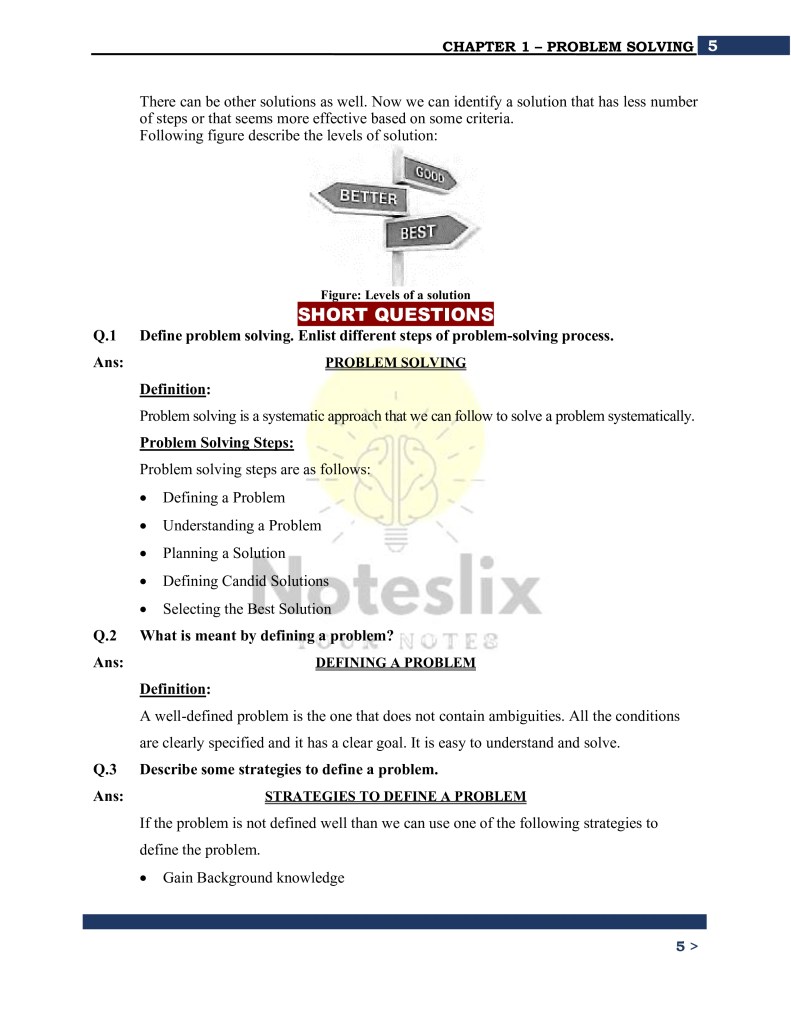Understanding computer science concepts is vital for students aiming to excel in their exams. Chapter 1, titled “Problem Solving,” introduces fundamental techniques essential for computational thinking and analytical skills.
This article provides an in-depth overview of Class 9 Computer Chapter 1 Solved Notes, focusing on key concepts, MCQs, short questions, and long questions.
These notes are designed to simplify complex topics, enabling students to grasp and retain information effectively.











































Topics Covered in These Notes
The notes cover the following main topics, based on the chapter’s index:
- Problem Solving Steps
- Defining a problem
- Understanding a problem
- Planning a solution
- Defining candid solutions
- Selecting the best solution
- Flowcharts
- Definitions and symbols
- Importance of flowcharts in problem-solving
- Examples of flowcharts
- Algorithms
- Definition and role in problem-solving
- Formulation of algorithms
- Efficiency of algorithms
- Differences between algorithms and flowcharts
- Test Data
- Types and importance of test data
- Examples and applications
- Verification and Validation
- Key differences with examples
- Identification and Correction of Errors
- Using trace tables
- Testing with invalid data
Class 9 Computer Chapter 1 Solved Notes Topic Wise
This section delves into the solved content, categorized to provide a clear understanding of each topic.
1. Problem Solving Steps
The chapter begins with defining problem-solving steps, emphasizing systematic approaches like:
- Defining a Problem: Clearly stated goals and conditions with minimal ambiguity.
- Planning a Solution: Techniques like divide-and-conquer, prototypes, and iterative refinement.
2. Flowcharts
Flowcharts are introduced as graphical tools to visualize problem-solving steps. Common flowchart symbols, such as ovals for start/end, rectangles for processes, and diamonds for decisions, are explained in detail.
Examples include flowcharts for assigning grades and determining weekday names from numbers.
3. Algorithms
Algorithms are step-by-step instructions for solving problems. For example, the chapter includes:
- Algorithm for calculating acceleration using mass and force.
- Efficiency metrics of algorithms: number of steps and memory usage.
4. Test Data
Practical examples of test data illustrate:
- Valid Test Data: Inputs meeting requirements.
- Invalid Test Data: Ensures solutions handle unexpected inputs.
- Boundary Values: Testing extreme cases, such as very large or zero values.
5. Verification and Validation
- Verification ensures the solution addresses the intended problem (e.g., compound interest calculation).
- Validation confirms the correctness of the solution.
6. Error Identification and Correction
The chapter highlights using trace tables to identify logical errors in algorithms. For example, checking the steps of a volleyball team selection algorithm ensures no incorrect output.
Tool for Success in Exams
The provided notes serve as a powerful tool for exam preparation by:
- Summarizing key concepts for quick revision.
- Offering step-by-step solutions to long and short questions.
- Providing a systematic approach to complex problems, ensuring a strong conceptual foundation.
Colored Notes for Enhanced Learning
These notes include diagrams and flowcharts with distinct colors, helping students visualize and understand concepts more effectively. Color-coded sections also make it easier to differentiate between topics, boosting retention and recall.
Notes Are Free to Use
Access to these comprehensive notes is entirely free. Students can easily review, download, and share them without any restrictions. This ensures that quality learning material is accessible to everyone.
Notes Are Mistake-Free
These notes have been meticulously reviewed to ensure accuracy. Whether it’s algorithm steps or flowchart representations, every detail has been cross-verified to avoid errors. This guarantees students can rely on these notes without hesitation.
Conclusion
Chapter 1 of Class 9 Computer Science lays the foundation for problem-solving and computational thinking. These notes simplify challenging concepts, provide error-free solutions, and include practice material for exams.
With structured explanations, visual aids, and easy accessibility, these notes are indispensable for students aiming to excel.
Other Class 9 Computer Solved Notes Topic Wise
- Class 9 Computer Chapter 2 Solved Notes Topic Wise
- Class 9 Computer Chapter 3 Solved Notes Topic Wise
- Class 9 Computer Chapter 4 Solved Notes Topic Wise
- Class 9 Computer Chapter 5 Solved Notes Topic Wise

